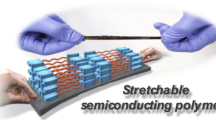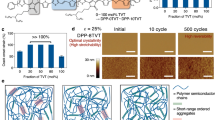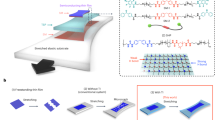Abstract
In the future Internet of Everything (IoE) society, wearable intelligent electronic devices will receive much attention. Semiconducting polymer materials with good stress-releasing properties have been sought for development of novel intrinsically stretchable semiconducting materials that possess excellent mechanical properties and endurance toward applied strains. Recently, strategies for modulating π-conjugated polymers have been developed to produce intrinsically stretchable semiconducting materials possessing excellent electronic and stress-releasing properties. Indeed, intrinsically stretchable “p-type” semiconducting polymer materials have been developed based on both main-chain engineering and side-chain engineering. However, only a few examples of intrinsically stretchable “n-type” semiconducting polymer materials have been reported. In this focus review, our recent progress in main-chain engineering for development of intrinsically stretchable n-type semiconducting materials is described. The topics include four strategies, namely, (i) a conjugation-break spacer approach, (ii) a block copolymer approach, (iii) an all-conjugated statistical terpolymer approach, and (iv) a sequence random copolymer approach, in which specially designed stress-relaxation units or sequences are incorporated along the main chains of naphthalene-diimide-based n-type semiconducting polymers.
This is a preview of subscription content, access via your institution
Access options
Subscribe to this journal
Receive 12 print issues and online access
$259.00 per year
only $21.58 per issue
Buy this article
- Purchase on Springer Link
- Instant access to full article PDF
Prices may be subject to local taxes which are calculated during checkout







Similar content being viewed by others
References
Tsumura A, Koezuka H, Ando T. Macromolecular electronic device: Field-effect transistor with a polythiophene thin film. Appl Phys Lett. 1986;49:1210–2.
Sirringhaus H, Tessler N, Friend RH. Integrated optoelectronic devices based on conjugated polymers. Science. 1998;280:1741–4.
Yao Y, Dong H, Liu F, Russell TP, Hu W. Approaching intra- and interchain charge transport of conjugated polymers facilely by topochemical polymerized single crystals. Adv Mater. 2017;29:1701251.
Zhao Y, Zhao X, Zang Y, Di C, Diao Y, Mei J. Conjugation-break spacers in semiconducting polymers: impact on polymer processability and charge transport properties. Macromolecules. 2015;48:2048–53.
Melenbrink EL, Hilby KM, Alkhadra MA, Samal S, Lipomi DJ, Thompson BC. Influence of systematic incorporation of conjugation-break spacers into semi-random polymers on mechanical and electronic properties. ACS Appl Mater Interfaces. 2018;10:32426–34.
Mun J, Wang GJN, Oh JY, Katsumata T, Lee FL, Kang J, et al. Effect of nonconjugated spacers on mechanical properties of semiconducting polymers for stretchable transistors. Adv Funct Mater. 2018;28:1804222.
Melenbrink EL, Hilby KM, Choudhary K, Samal S, Kazerouni N, McConn JL, et al. Influence of acceptor side-chain length and conjugation-break spacer content on the mechanical and electronic properties of semi-random polymers. ACS Appl Polym Mater. 2019;1:1107–17.
Oh JY, Rondeau-Gagné S, Chiu YC, Chortos A, Lissel F, Wang GJN, et al. Intrinsically stretchable and healable semiconducting polymer for organic transistors. Nature. 2016;539:411–5.
Galuska LA, McNutt WW, Qian Z, Zhang S, Weller DW, Dhakal S, et al. Impact of backbone rigidity on the thermomechanical properties of semiconducting polymers with conjugation break spacers. Macromolecules. 2020;53:6032–42.
Chen AX, Kleinschmidt AT, Choudhary K, Lipomi DJ. Beyond stretchability: strength, toughness, and elastic range in semiconducting polymers. Chem Mater. 2020;32:7582–601.
Lin YC, Matsuda M, Chen CK, Yang WC, Chueh CC, Higashihara T, et al. Investigation of the mobility–stretchability properties of naphthalenediimide-based conjugated random terpolymers with a functionalized conjugation break spacer. Macromolecules. 2021;54:7388–99.
Lin YC, Matsuda M, Sato K, Chen CK, Yang WC, Chueh CC, et al. Intrinsically stretchable naphthalenediimide–bithiophene conjugated statistical terpolymers using branched conjugation break spacers for field–effect transistors. Polym Chem. 2021;12:6167–78.
Printz AD, Savagatrup S, Burke DJ, Purdya TN, Lipomi DJ. Increased elasticity of a low-bandgap conjugated copolymer by random segmentation for mechanically robust solar cells. RSC Adv. 2014;4:13635–43.
Lin YC, Huang YW, Hung CC, Chiang YC, Chen CK, Hsu LC, et al. Backbone engineering of diketopyrrolopyrrole-based conjugated polymers through random terpolymerization for improved mobility-stretchability property. ACS Appl Mater Interfaces. 2020;12:50648–59.
Müller C, Goffri S, Breiby DW, Andreasen JW, Chanzy HD, Janssen RAJ, et al. Stingelin-Stutzmann N. Tough, semiconducting polyethylene-poly(3-hexylthiophene) diblock copolymers. Adv Funct Mater. 2007;17:2674–9.
Wang JT, Takshima S, Wu HC, Shih CC, Isono T, Kakuchi T, et al. Stretchable conjugated rod–coil poly(3-hexylthiophene)-block-poly(butyl acrylate) thin films for field effect transistor applications. Macromolecules. 2017;50:1442–52.
Peng R, Pang B, Hu D, Chen M, Zhang G, Wang X, et al. An ABA triblock copolymer strategy for intrinsically stretchable semiconductors. J Mater Chem C. 2015;3:3599–606.
Miyane S, Mori H, Higashihara T. Synthesis and characterization of all-conjugated hard-soft-hard ABA triblock copolythiophene. Microsist Technol. 2016;22:3–10.
Li X, Wolanin PJ, MacFarlane LR, Harniman RL, Qian J, Gould OEC, et al. Uniform electroactive fibre-like micelle nanowires for organic electronics. Nat Commun. 2017;8:15909.
Goto E, Ochiai Y, Lo CT, Koganezawa T, Ueda M, Higashihara T. Synthesis of regioblock copolythiophene by Negishi catalyst-transfer polycondensation using tBu2Zn·2LiCl. Polym Chem. 2017;8:6143–9.
Sugiyama F, Kleinschmidt AT, Kayser LV, Alkhadra MA, Wan JM, Chiang AS, et al. Stretchable and degradable semiconducting block copolymers. Macromolecules. 2018;51:5944–9.
Miyane S, Wen HF, Chen WC, Higashihara T. Synthesis of block copolymers comprised of poly(3-hexylthiophene) segment with trisiloxane side chains and their application to organic thin film transistor. J Polym Sci Part A: Polym Chem. 2018;56:1787–94.
Higashihara T, Fukuta S, Ochiai Y, Sekine T, Chino K, Koganezawa T, et al. Synthesis and deformable hierarchical nanostructure of intrinsically stretchable ABA triblock copolymer comprised of poly(3-hexylthiophene) and polyisobutylene segments. ACS Appl Polym Mater. 2019;1:315–20.
Higashihara T, Fukuta S, Koganezawa T, Chino K. Morphological study of blend thin films of poly(3-hexylthiophene)-block-polyisobutylene-block-poly(3-hexylthiophene):poly(3-hexylthiophene) and their application to photovoltaics. J Photopolym Sci Technol. 2019;32:741–6.
Park H, Ma BS, Kim JS, Kim Y, Kim HJ, Kim D, et al. Regioregular-block-regiorandom poly(3-hexylthiophene) copolymers for mechanically robust and high-performance thin-film transistors. Macromolecules. 2019;52:7721–30.
Lei T, Dou JH, Pei J. Influence of alkyl chain branching positions on the hole mobilities of polymer thin-film transistors. Adv Mater. 2012;24:6457–61.
Wu HC, Hung CC, Hong CW, Sun HS, Wang JT, Yamashita G, et al. Isoindigo-based semiconducting polymers using carbosilane side chains for high performance stretchable field-effect transistors. Macromolecules. 2016;49:8540–8.
Chiang YC, Wu HC, Wen HF, Hung CC, Hong CW, Kuo CC, et al. Tailoring carbosilane side chains toward intrinsically stretchable semiconducting polymers. Macromolecules. 2019;52:4396–404.
Lin YC, Chen CK, Chiang YC, Hung CC, Fu MC, Inagaki S, et al. Study on intrinsic stretchability of diketopyrrolopyrrole-based π-conjugated copolymers with poly(acryl amide) side chains for organic field-effect transistors. ACS Appl Mater Interfaces. 2020;12:33014–27.
Saito Y, Sakai Y, Higashihara T, Ueda M. Direct patterning of poly(3-hexylthiophene) and its application to organic field-effect transistor. RSC Adv. 2012;2:1285–8.
Wang GJN, Shaw L, Xu J, Kurosawa T, Schroeder BC, Oh JY, et al. Inducing elasticity through oligo-siloxane crosslinks for intrinsically stretchable semiconducting polymers. Adv Funct Mater. 2016;26:7254–62.
Miyane S, Higashihara T. Development of cross-linked polythiophene with oligoisobutylene side chains. The 67th SPSJ meeting. Prepr; 2018. No. 3D07.
Wang GJN, Zheng Y, Zhang S, Kang J, Wu HC, Gasperini A, et al. Tuning the cross-linker crystallinity of a stretchable polymer semiconductor. Chem Mater. 2019;31:6465–75.
Wu HC, Lissel F, Wang GJN, Koshy DM, Nikzad S, Yan H, et al. Metal-ligand based mechanophores enhance both mechanical robustness and electronic performance of polymer semiconductors. Adv Funct Mater. 2021;31:2009201.
Higashihara T. Strategic design and synthesis of π-conjugated polymers suitable as intrinsically stretchable semiconducting materials. Polym J. 2021;53:1061–71.
Zheng Y, Zhang S, Tok JBH, Bao Z. Molecular design of stretchable polymer semiconductors: current progress and future directions. J Am Chem Soc. 2022;144:4699–715.
Anthony JE, Facchetti A, Heeney M, Marder SR, Zhan X. n-Type organic semiconductors in organic electronics. Adv Mater. 2010;22:3876–92.
Guo X, Facchetti A, Marks TJ. Imide- and amide-functionalized polymer semiconductors. Chem Rev. 2014;114:8943–9021.
Genene Z, Mammo W, Wang E, Andersson MR. Recent Advances in n-type polymers for all-polymer solar cells. Adv Mater. 2019;31:1807275.
Sui Y, Deng Y, Du T, Shi Y, Geng Y. Design strategies of n-type conjugated polymers for organic thin-film transistors. Mater Chem Front. 2019;3:1932–51.
Sun H, Guo X, Facchetti A. High-performance n-type polymer semiconductors: applications, recent development, and challenges. Chem. 2020;6:1310–26.
Huang J, Yu G. Structural engineering in polymer semiconductors with aromatic N-heterocycles. Chem Mater. 2021;33:1513–39.
Chen Z, Zheng Y, Yan H, Facchetti A. Naphthalenedicarboximide- vs perylenedicarboximide-based copolymers. Synthesis and semiconducting properties in bottom-bate n-channel organic transistors. J Am Chem Soc. 2009;131:8–9.
Zhan X, Tan Z, Domercq B, An Z, Zhang X, Barlow S, et al. A high-mobility electron-transport polymer with broad absorption and its use in field-effect transistors and all-polymer solar cells. J Am Chem Soc. 2007;129:7246–7.
Fukutomi Y, Nakano M, Hu JY, Osaka I, Takimiya K. Naphthodithiophenediimide (NDTI): synthesis, structure, and applications. J Am Chem Soc. 2013;135:11445–8.
Tu D, Qiao Y, Ni Y, Guo X, Li C. Structural engineering of anthracene diimide polymers for molecular ordering manipulation. Macromolecules. 2022;55:4102–10.
Usta H, Facchetti A, Marks TJ. Air-stable, solution-processable n-channel and ambipolar semiconductors for thin-film transistors based on the indenofluorenebis(dicyanovinylene) core. J Am Chem Soc. 2008;130:8580–1.
Gao Y, Deng Y, Tian H, Zhang J, Yan D, Geng Y, et al. Multifluorination toward high-mobility ambipolar and unipolar n-type donor–acceptor conjugated polymers based on isoindigo. Adv Mater. 2017;29:1606217.
Mueller CJ, Singh CR, Fried M, Huettner S, Thelakkat M. High bulk electron mobility diketopyrrolopyrrole copolymers with perfluorothiophene. Adv Funct Mater. 2015;25:2725–36.
Li R, Dai Z, Zheng M, Wang C, Deng Z, Zhuang T, et al. Benzo/naphthodifuranone-based polymers: effect of perpendicular-extended main chain π-conjugation on organic field-effect transistor performances. Macromol Rapid Commun. 2021;42:2000703.
Iguchi K, Mikie T, Saito M, Komeyama K, Seo T, Ie Y, et al. N-type semiconducting polymers based on dicyano naphthobisthiadiazole: high electron mobility with unfavorable backbone twist. Chem Mater. 2021;33:2218–28.
Mikie T, Okamoto K, Iwasaki Y, Koganezawa T, Sumiya M, Okamoto T, et al. Naphthobispyrazine bisimide: a strong acceptor unit for conjugated polymers enabling highly coplanar backbone, short π–π stacking, and high electron transport. Chem Mater. 2022;34:2717–29.
Lei T, Dou JH, Cao XY, Wang JY, Pei J. A BDOPV-based donor–acceptor polymer for high-performance n-type and oxygen-doped ambipolar field-effect transistors. Adv Mater. 2013;25:6589–93.
Zheng YQ, Lei T, Dou JH, Xia X, Wang JY, Liu CJ, et al. Strong electron-deficient polymers lead to high electron mobility in air and their morphology-dependent transport behaviors. Adv Mater. 2016;28:7213–9.
Wang Y, Guo H, Harbuzaru A, Uddin MA, Arrechea-Marcos I, Ling S. et al. (Semi)laddertype bithiophene imide-based all-acceptor semiconductors: synthesis, structure–property correlations, and unipolar n-type transistor performance. J Am Chem Soc. 2018;140: 6095–108.
Wang Y, Hasegawa T, Matsumoto H, Michinobu T. Significant improvement of unipolar n-type transistor performances by manipulating the coplanar backbone conformation of electron-deficient polymers via hydrogen bonding. J Am Chem Soc. 2019;141:3566–75.
Choi J, Kim W, Kim D, Kim S, Chae J, Choi SQ, et al. Importance of critical molecular weight of semicrystalline n-type polymers for mechanically robust, efficient electroactive thin films. Chem Mater. 2019;31:3163–73.
Zhang S, Cheng YH, Galuska L, Roy A, Lorenz M, Chen B, et al. Tacky elastomers to enable tear-resistant and autonomous self-healing semiconductor composites. Adv Funct Mater. 2020;30:2000663.
Tian F, Chen H, Du Y, Chen J, Wang X, Lu H, et al. Rational molecular design for isoindigo-based polymer semiconductors with high ductility and high electrical performance. J Mater Chem C. 2019;7:11639–49.
Erdmann T, Fabiano S, Milián-Medina B, Hanifi D, Chen Z, Berggren M, et al. Naphthalenediimide polymers with finely tuned in-chain π-conjugation: electronic structure, film microstructure, and charge transport properties. Adv Mater. 2016;28:9169–74.
Bates CM, Bates FS. 50th anniversary perspective: block polymers-pure potential. Macromolecules. 2017;50:3–22.
Lodge TP. Block copolymers: long-term growth with added value. Macromolecules. 2020;53:2–4.
Müller C, Goffri S, Breiby DW, Andreasen JW, Chanzy HD, Janssen RAJ, et al. Tough, semiconducting polyethylene-poly(3-hexylthiophene) diblock copolymers. Adv Funct Mater. 2007;17:2674–79.
Sato K, Hemmi Y, Kato A, Matsui H, Fuchise K, Higashihara T. Precise synthesis of α,ω-chain-end-functionalized poly(dimethylsiloxane) with bromoaryl groups for incorporation in naphthalene-diimide-based N-type semiconducting polymers. Polymer. 2022;252:124934.
Mun J, Ochiai Y, Wang W, Zheng Y, Zheng YQ, Wu HC, et al. A design strategy for high mobility stretchable polymer semiconductors. Nat Commun. 2021;12:3572.
Lin YC, Terayama K, Yoshida K, Yu PJ, Chueh PH, Chueh CC, et al. Strain-insensitive naphthalene-diimide-based conjugated polymers through sequential regularity control. Mater Chem Front. 2022;6:891–900.
Acknowledgements
TH thanks the Japan Society for the Promotion of Science (JSPS), KAKENHI (No. 21H02009) and Tokuyama Science Foundation for financial support.
Author information
Authors and Affiliations
Corresponding author
Ethics declarations
Conflict of interest
The authors declare no competing interests.
Additional information
Publisher’s note Springer Nature remains neutral with regard to jurisdictional claims in published maps and institutional affiliations.
Rights and permissions
Springer Nature or its licensor (e.g. a society or other partner) holds exclusive rights to this article under a publishing agreement with the author(s) or other rightsholder(s); author self-archiving of the accepted manuscript version of this article is solely governed by the terms of such publishing agreement and applicable law.
About this article
Cite this article
Matsuda, M., Sato, Ki., Terayama, K. et al. Synthesis of electron deficient semiconducting polymers for intrinsically stretchable n-type semiconducting materials. Polym J 55, 365–373 (2023). https://doi.org/10.1038/s41428-022-00729-6
Received:
Revised:
Accepted:
Published:
Issue Date:
DOI: https://doi.org/10.1038/s41428-022-00729-6



